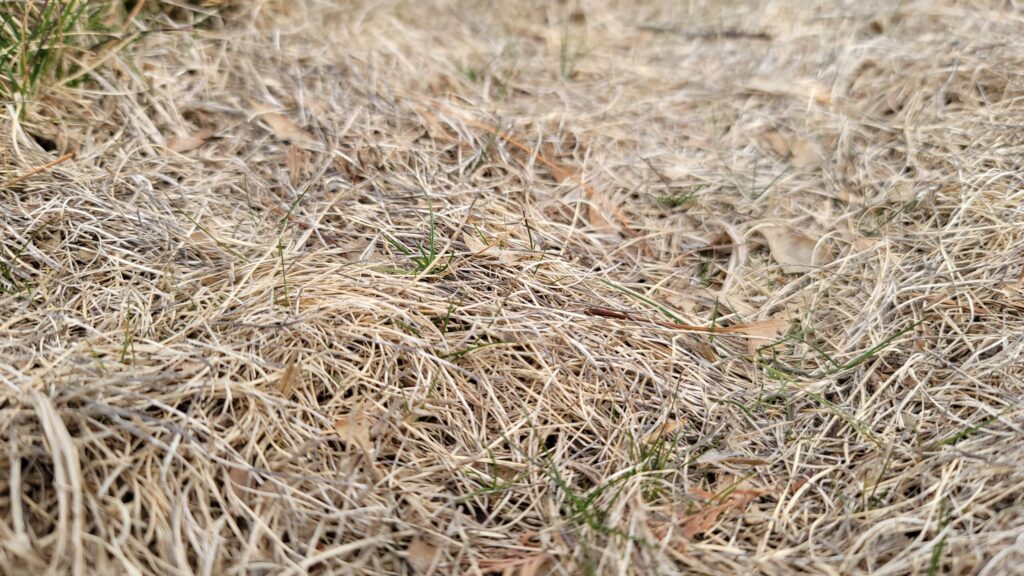Main Content
Typically, turf management isn’t on top of the to-do list in mid-February. But winter in New Jersey isn’t typical typical this year. The statewide average temperature in January 2023 was 41.0°, which was 9.3° above the 1991–2020 normal and ties with 1932 as the mildest January since records commenced in 1895. For more details on a winter weather recap see the Rutger NJ Weather Network at https://www.njweather.org/.
Some may be asking, what does this mean for the overseeding I did last fall to renovate my turf? The answer depends, in part, on what seed mix or blend was used and when was it seeded. The minimum temperatures for seed germination are poorly defined because of the extreme slowness of germination at low temperatures. But observations of late-fall seedings clearly indicate that tall fescue and Kentucky bluegrass seed does not effectively develop a seedling turf once soil temperatures drop to 50° F. Late-fall seedings with fine fescue will also be slow but greater seedling development may be seen with the red fescues (strong creeping red and Chewings). Among the cool season grasses used for turf, perennial ryegrass has the greatest chance for development of turf cover from a late-fall seeding since the species has been observed to germinate at temperatures below 40° F but above freezing.
Because of the mild winter weather, it would be useful to scout any areas of turf that were overseeded last fall to identify and document the extent of seedling emergence and development. This will serve as a benchmark for future assessments and indicators of progress for turf renovation during the approaching spring.

Mild weather may be encouraging some to consider dormant seeding, which is the process of applying seed with the knowledge that it will not germinate (remains dormant) until environmental conditions are favorable for germination later in the spring. For cool-season grasses, that generally means seed will not germinate until soil temperatures are consistently above 50° F. And it is important to understand that air temperature will probably need to be 60° F or above before soil temperatures will be consistently above 50° F. Soil temperature at the 2-inch depth is currently averaging above 40° F at the turfgrass research farm in North Brunswick, NJ.
Dormant seedings have greater risks associated with higher seedling mortality and loss from wash-outs, bird feeding, etc. Mortality can occur if the seed germinates and then a hard frost occurs and kills the seedlings. Losses due to wash-out and bird feeding are greater because proper soil preparation during the winter is limited by excessive soil moisture or frozen conditions dictating that dormant seeding are reliant on frost-action to incorporate seed into the soil. As a result, seed rates for dormant seeding are often increased by 30 to 50 percent as an attempt to offset these possible losses.
When attempting dormant seeding, consider using walk-behind spreaders and other equipment that won’t cause soil damage and compaction. If the soil is dry and firm enough, heavier equipment may be used but dry, firm conditions are often not the case, especially when the soil has frost heaved or rains have saturated the soil. Also, do not add a fertilizer product during winter dormant seeding operations in accordance with sound environmental stewardship. Fertilizers should never be applied to snow-covered or frozen soils as there is a high risk of fertilizer runoff.
If rapid ground cover is a primary goal for dormant seeding, perennial ryegrass will provide the fastest rate of establishment. Also, covering a dormant seeding with a growth blanket will be a great aid to germination and establishment. Growth blankets protect the seed from wash-outs, wind blowing, and bird feeding and retain moisture and heat, thereby accelerating the establishment rate and extending the growing season. Growth blankets also discourage people from trafficking and disturbing the area.
In summary, dormant seedings are much riskier than seeding at more ideal times. This doesn’t mean dormant seeding aren’t or shouldn’t be done, but it does mean expectations need to be tempered based on the associated risks. And it would be wise to have alternate plan ready should the dormant seeding not achieve the expected outcome.